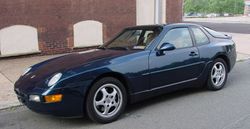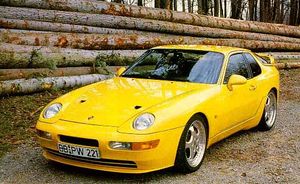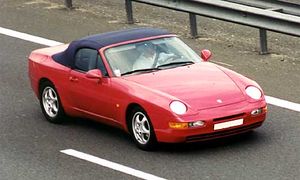.
Porsche 968: Difference between revisions
No edit summary |
No edit summary |
||
| Line 49: | Line 49: | ||
| | | | ||
|} | |} | ||
The [[Porsche]] company was in dire straits at the beginning of the 1990s | The [[Porsche]] company was in dire straits at the beginning of the 1990s and global recession had hit the market for sportscars hard. Gone were the yuppies that had kept Porsche afloat in the 1980s. The model range was stagnant and dated, and proving unconvincing to consumers. CEOs and board members were often at conflict. The racing projects, the part of the company that was termed representative of the whole company, showed how much Porsche was from the mark - the Indycar projects ended unconvincingly, and the Arrows F1 project was dire - the only highlight was a spectacular car-splitting crash at Monaco. | ||
The decision was taken to update the most successful model of the range - the [[Porsche 944|944]] - which in truth had needed replacing in 1988. The new car, to be called the '''968''', was to use many 944 S2 parts, due to restrictions on the company's bank account. The result was unveiled in August 1991. | The decision was taken to update the most successful model of the range - the [[Porsche 944|944]] - which in truth had needed replacing in 1988. The new car, to be called the '''968''', was to use many 944 S2 parts, due to restrictions on the company's bank account. The result was unveiled in August 1991. | ||
Revision as of 22:05, 13 February 2007

| |
| Porsche 968 | |
|---|---|
| Porsche | |
| aka | Porsche 968 Lux Porsche 968 Clubsport |
| Production | 1992-1995 |
| Class | Sports Luxury |
| Body Style | Coupe or Cabriolet |
| Length | 4320 mm |
| Width | 1735 mm |
| Height | 1275 mm |
| Wheelbase | 2400 mm |
| Weight | 1370 KG (Lux Coupe) |
| Transmission | 6-speed Manual Tiptronic Sequential |
| Engine | 3.0 litre 4-cylinder |
| Power | 240 BHP (Lux) |
| Similar | Mazda RX-7 Mercedes SL |
| Designer | |
The Porsche company was in dire straits at the beginning of the 1990s and global recession had hit the market for sportscars hard. Gone were the yuppies that had kept Porsche afloat in the 1980s. The model range was stagnant and dated, and proving unconvincing to consumers. CEOs and board members were often at conflict. The racing projects, the part of the company that was termed representative of the whole company, showed how much Porsche was from the mark - the Indycar projects ended unconvincingly, and the Arrows F1 project was dire - the only highlight was a spectacular car-splitting crash at Monaco.
The decision was taken to update the most successful model of the range - the 944 - which in truth had needed replacing in 1988. The new car, to be called the 968, was to use many 944 S2 parts, due to restrictions on the company's bank account. The result was unveiled in August 1991.
83% New
Porsche engineers claimed the 968 was '83 % new' over the outgoing 944, a statistic in itself which proves how desparate it was for success with the model. Over the 944 S2, the 968 benefitted from new front wings, lights, front bumper, side skirts and rear bumper - but it lifted the power plant, albeit with new variable valve timing' and drivetrain straight from the previous model. The specifications were very similar, with colour charts changing only in name, but at least a fresh alloy wheel design complimented the contemporary exterior - the 'Cup One' style single alloys became the base of Porsche's current range of alloy wheels.
Despite all this promise, press reaction, and subsequent public reaction, was underwhelming. 'Lacks flair' was the succinct comment from a reviewer.
To try to generate some interest in the model, Porsche released the Cabriolet version, which generated a slight shift in interest, due to its better looks, but still failed to sell in anywhere near the volume of its predecessor. An automatic option was offered, in the promising shape of 'Tiptronic', but this was not the answer. Funds still prevented the replacement of the range, and so Porsche set about tweaking the standard coupe, and in December 1992, the Club Sport was announced. Things were looking up for the model, after a very slow start.
Models
The Club Sport
Rushed out to try to generate some sales from the traditional enthusiast Porsche buyer, the 968 Club Sport was released to a sceptical media in December 1992. Costing nearly 20% less than a standard 968, the Club Sport harked back to the days of the proper Porsche - the RS. Trim levels were very basic, and was only offered in five exterior colours (Black, Maritime Blue, Guards Red, White and Speed Yellow) with the single interior option - black cloth. As standard, bucket Recaro seats were specified, with colour-coordinated back rests, along with a bold 'Club Sport' decal running the length of the sills and colour-coorinated alloy wheels. The decal and wheel colour could be customer deleted - this was the recession, after all. Rear seats were deleted, as were the standard springs (replaced with stiffer examples), heated windows, rear wiper, electric mirror adjustment, electric boot release and the standard battery and alternator.
Porsche claimed a saving of 50kg over the 968 - but in markets such as the UK, the weight loss was a massive 100kg, due to the standard 'Lux' pack which added weight to the Club Sport's standard sibling. Very few options were offered to 968 Club Sport buyers, but one stood out - the M030 pack, comprising of stiffer springs, stiffer shock absorbers, thicker anti-roll bars, larger drilled brake discs and a Torsen differential.
The press gushed over the car, with British magazine 'Autocar' branding it 'Car of the Year' and 'Best Handling Car' in 1993. The 968 Club Sport generated the interest Porsche wanted, but it was never going to solve the sales problem. However, in the Porsche 968 Club Sport, they had created a gem.
The Turbo S
Much like the 944 Turbo S and the 924 Carrera GT before it, the 968 Turbo S represented the pinnacle of the range. The car was built to homologate the use of the 968 in various classes of motorsport, including Le Mans, European, Middle Eastern and American GT championships.
The interesting fact is that Porsche never built a 'non-S' 968 Turbo. The reason for this was that the previous generations of front-engined Turbo cars had not sold as well as expected - and Porsche could not spend their valuable funds on a vehicle that would not represent a profit on the market. However, mounting pressures from racing customers demanded a new car to replace the ageing 944 Turbo Cup cars and IMSA racers - hence, the 968 Turbo S was hastily scrabbled together.
The Turbo S was destined for the race track from its inception, and like the 924 Carrera GTR, could only be purchased directly from Porsche's motorsport division in Weissach. The car was road legal, and at least two examples were in road use. The car used a Club Sport as a basis, but new features included split-rim alloys, an adjustable rear wing, further stripped interior with rollcage and fire extinguisher, bucket seats, and of course, the turbocharged 3.0 litre four-cylinder engine. The engine developed 305BHP and a massive 500NM of torque, supplying the car with sub-4 second 0-62 kmh times and a top speed of 175 mph.
Of course, the car was a sales flop, but proved that in times of hard cash Porsche still had the ability to produce drool-inducing automobiles.
The Sport
The Sport was a UK-only edition, that was introduced in 1994 and stayed on the price lists until the 968's end. The Sport was a Club Sport with some equipment returned to the cabin - sound deadening, air conditioning, comfort-spec seats, proper stereo - as well as a relaxing of the colour options - the Club Sport colour package was available along with the standard catalogue.
The Sport was one of the best selling models in the UK, and ensured, that after shaky beginnings, the 968 finished its short life on a high.
The 968 gave way to the Boxster in 1996, with a few cars in all markets finding homes in late 1996.
Summary
- 1992-1995 - Porsche 968 Coupe
- 1993-1995 - Porsche 968 Cabriolet
- 1993-1995 - Porsche 968 Club Sport
- 1993-1995 - Porsche 968 Turbo S Coupe
- 1994-1995 - Porsche 968 Sport


